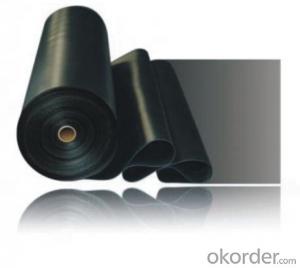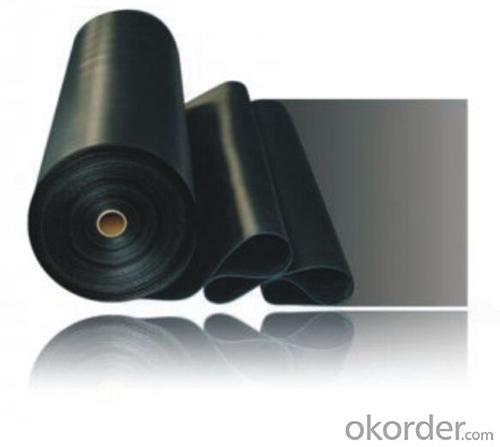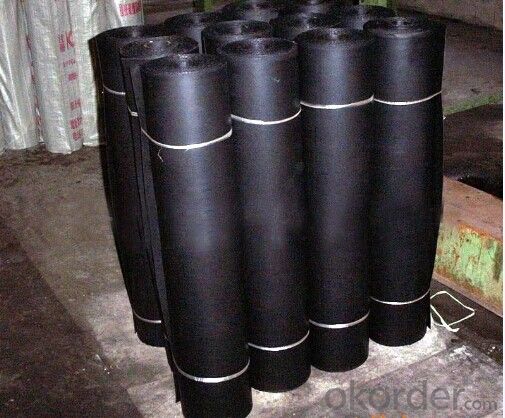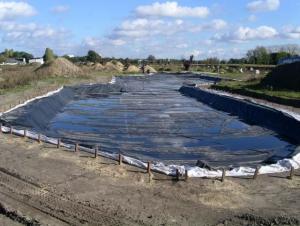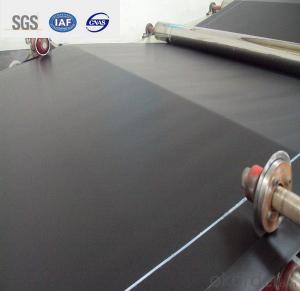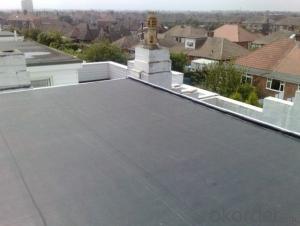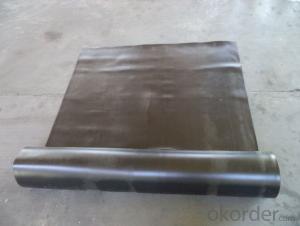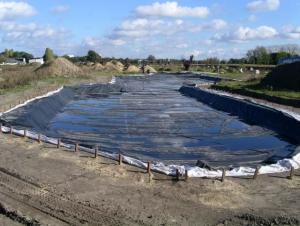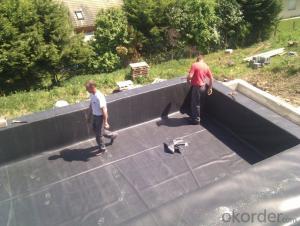EPDM Weldable Waterproofing Membrane for Pond Use
- Loading Port:
- Qingdao
- Payment Terms:
- TT or LC
- Min Order Qty:
- 2000 m²
- Supply Capability:
- 200000 m²/month
OKorder Service Pledge
OKorder Financial Service
You Might Also Like
EPDM waterproofing Rubber membrane
1. Product Description:
EPDM waterproofing membrane is the modified materials. They are based upon EPDM rubber with modifier, softener and accelerant assistants added to provide flexibility and stability . Through the precise ingredients, mixing, extrusion, rolling, curing processes to made of modified EPDM Waterproofing material with high strength and high flexibility.
2. Product Specification:
Type | EPDM Weldable Waterproof Membrane | ||
Material | EPDM Rubber | ||
Thickness | 1.2mm | 1.5mm | 2.0mm |
Weight(kg/m2) | 1.54-1.58 | 1.79-1.83 | 2.25-2.29 |
Size | 1.2m-4m(width) * 20m(length)/roll | ||
Type | Weldable | ||
Pattern | Non-reinforced(homogeneous) | ||
Packing | with plastic bag and then several bags in one pallet | ||
Color | Black | ||
Application | Roof, basement, pond, Lake, steel structure roof, swimming pool, underground, tunnel, etc | ||
There are two installation ways.one is full sticking,the other is hot welding.
3. Technical Data:
1 | Tolerance on size | Thickness | % | ±10 | |
Width | % | ±1 | |||
length | % | Does not allow negative | |||
2 | Fracture tensile strength (normal temperature ) | Mpa | ≥7.5 | ||
Fracture tensile strength(60 degree) | Mpa | ≥2.3 | |||
3 | Breaking elongation,(normal temperature ) | % | ≥450 | ||
Breaking elongation,(zero 20 degree) | % | ≥200 | |||
4 | Tearing resistance | KN/m | ≥25 | ||
5 | impermeability | * | 0.3Mpa impermeable | ||
6 | Bending at low temperature | °C | ≤-40 | ||
7 | Elongation and contraction volume at heating | Elongation | mm | ≤2 | |
contraction | mm | ≤4 | |||
8 | Hot air aging 80°CX168h | Fracture strength retention | % | ≥80 | |
Rate of elongation at break | % | ≥80 | |||
9 | Alkaline (saturated Ca(OH)2 solution normal Temperature x2 168h ) | Fracture strength retention | % | ≥80 | |
Rate of elongation at break | % | ≥80 | |||
10 | Ozone aging (40 degree by 168 hours ) | Elongation 40% , 500x10-2 | * | No Crack | |
11 | Phytotron aging | Fracture strength retention | % | ≥80 | |
Rate of elongation at break | % | ≥70 | |||
4. Product Application:
EPDM waterproof membranes form an effective barrier to liquid water or water vapor in the roof construction for industrial and civil engineering, underground engineering such as subway & tunnel, water conservancy such as water pools & ditch, shelter, grain depot, land filling, dyke and subwayt.
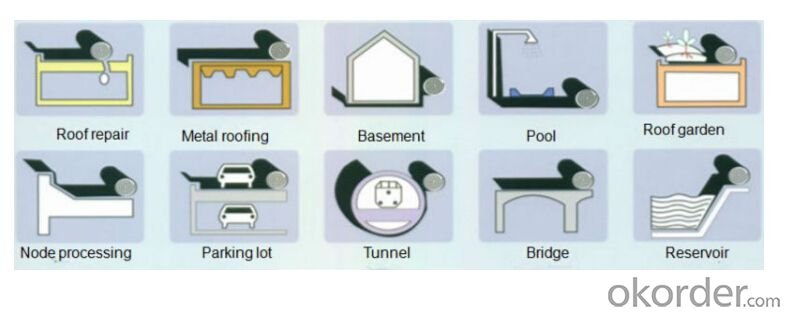
4. Some photos:
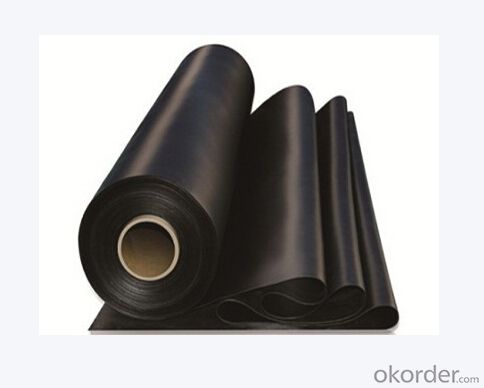
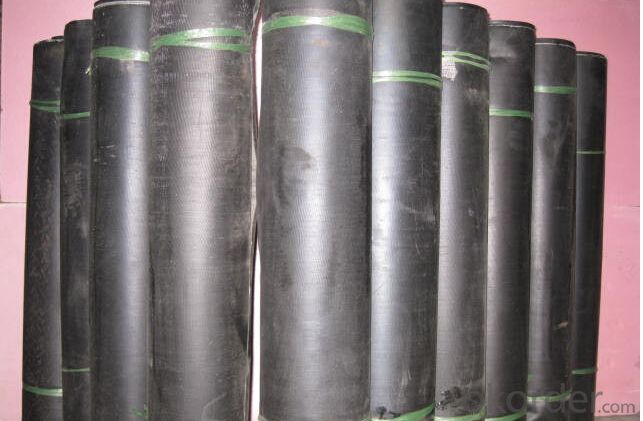
RFQ:
What's your payment terms?
T/T ,LC at sight
What's your pacakge?
One roll with one plastic bag, then several rolls in one pallet
What's your delivery time?
One week after received your payment
- Q: Are waterproofing membranes suitable for crawl spaces?
- Indeed, crawl spaces can be susceptible to moisture and water infiltration due to their positioning and inadequate ventilation. However, by implementing waterproofing membranes, one can effectively thwart water damage and issues arising from excessive moisture. These membranes are specifically engineered to establish a barricade against water and moisture, thereby preventing their intrusion into the crawl space and the subsequent development of problems like mold growth, decay, and structural deterioration. Moreover, the utilization of waterproofing membranes can contribute to enhancing the quality of indoor air by diminishing humidity levels in the crawl space. Consequently, it is strongly advised to employ waterproofing membranes in crawl spaces in order to guarantee a dry, sanitary, and healthful environment.
- Q: Can waterproofing membranes be used on foundation walls?
- Yes, waterproofing membranes can be used on foundation walls. Waterproofing membranes are specifically designed to prevent water infiltration and are commonly applied to foundation walls to protect them from moisture and water damage. These membranes are typically made of materials such as rubberized asphalt, thermoplastic, or PVC, which are durable and resistant to water penetration. They are installed on the exterior side of the foundation walls and provide an effective barrier against water, preventing it from seeping into the basement or crawl space. Waterproofing membranes are an essential component of building construction, as they help maintain the structural integrity of the foundation and prevent issues such as water damage, mold growth, and foundation settlement.
- Q: Can a waterproofing membrane be used for docks or marinas?
- Yes, a waterproofing membrane can indeed be used for docks or marinas. Waterproofing membranes are commonly used in construction to provide a barrier against water penetration. In the case of docks or marinas, where constant exposure to water is expected, a waterproofing membrane can be a valuable solution to protect the structure from water damage. Waterproofing membranes are typically made from materials such as rubber, PVC, or modified bitumen. These materials are designed to withstand water pressure and prevent water from seeping into the structure. They are applied as a continuous layer over the surface, creating a watertight seal. By installing a waterproofing membrane on docks or marinas, it helps to prevent water from penetrating the structure, which can result in damage over time. Water damage can lead to structural deterioration, rotting of wood, corrosion of metal components, and the growth of mold or mildew. Additionally, a waterproofing membrane can also provide protection against other elements such as UV rays, chemicals, and oil spills. It is important to ensure that the chosen waterproofing membrane is specifically designed for use in marine environments. This ensures that it can withstand the unique challenges posed by saltwater, fluctuating water levels, and the constant exposure to waves and tides. Additionally, it is crucial to follow proper installation procedures and maintenance guidelines to ensure the longevity and effectiveness of the waterproofing membrane. In summary, a waterproofing membrane can be a suitable solution for docks or marinas to protect them from water damage. It provides a reliable barrier against water penetration, helping to extend the lifespan of the structure and minimize maintenance requirements.
- Q: Can a waterproofing membrane be used in areas with high water pressure?
- Yes, a waterproofing membrane can be used in areas with high water pressure. Waterproofing membranes are designed to withstand and prevent water penetration, making them suitable for use in areas where there is high water pressure. However, it is important to ensure that the membrane chosen is specifically rated and designed to handle the specific water pressure levels in order to ensure its effectiveness and durability.
- Q: Can a waterproofing membrane be used for schools or universities?
- Yes, a waterproofing membrane can definitely be used for schools or universities. These membranes are designed to provide protection against water damage, preventing leaks and moisture intrusion in buildings. By installing a waterproofing membrane, schools and universities can ensure the longevity of their structures, protect valuable assets, and maintain a safe and comfortable environment for students and faculty.
- Q: Can a waterproofing membrane be used on tunnels with railway systems?
- Tunnels with railway systems can indeed utilize waterproofing membranes. These membranes are widely employed in tunnel construction to prevent water ingress and safeguard the tunnel structure against deterioration. By effectively sealing the tunnel walls, ceilings, and floors, they successfully prevent water from seeping into the tunnel, thereby averting potential damage to the railway system or infrastructure. Specifically designed to withstand the high-pressure conditions and constant vibrations associated with railway operations, these membranes are typically composed of durable materials like PVC, HDPE, or modified bitumen. Such materials not only offer excellent waterproofing properties but also ensure long-term durability. Moreover, these membranes can be effortlessly installed during the tunnel's construction phase or retrofitted onto existing tunnels, causing minimal disruption to railway operations. In essence, the utilization of waterproofing membranes has proven to be a reliable and efficient technique for ensuring the structural integrity and longevity of tunnels with railway systems.
- Q: What is the cost of a waterproofing membrane?
- There are several factors that can cause the cost of a waterproofing membrane to vary, including the type of membrane, the size of the area that needs to be covered, and how complex the installation is. Generally, the cost for materials alone ranges from $1 to $4 per square foot. However, it is crucial to keep in mind that there may be additional expenses for labor, equipment, or any repairs or preparation work that may be needed. Consequently, it is advised to seek quotes from reliable contractors or suppliers in order to obtain an accurate estimate for your particular project.
- Q: Are waterproofing membranes UV resistant?
- Yes, most waterproofing membranes are UV resistant. UV resistance is an essential property for waterproofing membranes as they are often exposed to sunlight. UV rays can cause degradation and deterioration of materials over time, leading to decreased effectiveness and durability of the membrane. Therefore, manufacturers of waterproofing membranes incorporate UV-resistant additives or coatings into their products to protect them from the harmful effects of UV radiation. This UV resistance helps to maintain the integrity and performance of the membrane, ensuring long-lasting protection against water penetration.
- Q: Can a waterproofing membrane be used on precast wood surfaces?
- Indeed, precast wood surfaces can benefit from the utilization of a waterproofing membrane. It is widely practiced to employ waterproofing membranes to shield diverse surfaces, such as wood, against water-related harm. These membranes are engineered with the purpose of establishing a barrier that obstructs the infiltration of water, thereby averting any potential structural problems or wood decay. By administering a waterproofing membrane to precast wood surfaces, one can successfully safeguard the wood from moisture and extend its durability. Nevertheless, it is crucial to verify the compatibility of the membrane with wood and adhere to the manufacturer's instructions for application in order to attain optimal outcomes.
- Q: Are waterproofing membranes resistant to high temperatures?
- Yes, waterproofing membranes are typically designed to be resistant to high temperatures. They are made from materials such as modified bitumen, PVC, or EPDM that have excellent heat resistance properties, allowing them to withstand high temperatures without degrading or losing their waterproofing capabilities.
Send your message to us
EPDM Weldable Waterproofing Membrane for Pond Use
- Loading Port:
- Qingdao
- Payment Terms:
- TT or LC
- Min Order Qty:
- 2000 m²
- Supply Capability:
- 200000 m²/month
OKorder Service Pledge
OKorder Financial Service
Similar products
Hot products
Hot Searches
Related keywords
